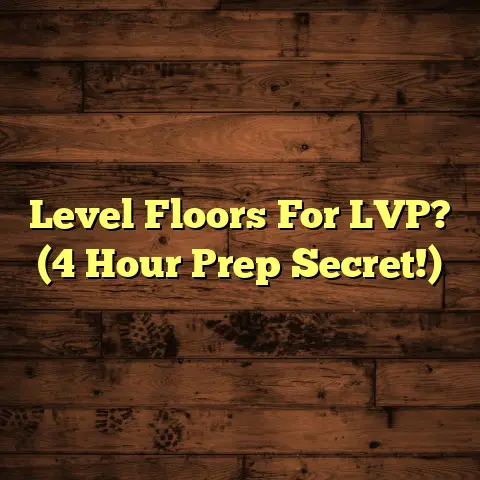How To Seal Quarry Tiles? (2 Sealer Types To Avoid!)
Today, we’re diving deep into the world of quarry tiles.
These beauties are known for their natural charm, rugged durability, and surprisingly easy cleaning.
But here’s the thing: quarry tiles are porous.
Think of them as tiny sponges just waiting to soak up spills, stains, and all sorts of gunk.
That’s where sealing comes in.
Sealing is the secret weapon that keeps your quarry tiles looking fantastic for years to come.
It’s like giving them a protective shield against the elements.
But not all sealers are created equal.
Trust me, I’ve learned this the hard way.
So, grab a cup of coffee, and let’s get started on this journey to sealing quarry tiles like a pro!
1. Understanding Quarry Tiles
Alright, let’s start with the basics. What exactly are quarry tiles?
Well, they’re not actually made from quarries, despite the name.
Quarry tiles are typically made from natural materials like clay, shale, or a combination of both.
These materials are ground, mixed with water, and then fired at extremely high temperatures.
This process gives them their signature strength, density, and resistance to water and wear.
You’ll often find quarry tiles in high-traffic areas like kitchens, entryways, and even commercial spaces.
I’ve installed them in restaurants, breweries, and even a few industrial settings.
They’re incredibly versatile!
As for colors and finishes, you’ve got a wide range to choose from.
From the classic red and brown tones to more contemporary grays and blacks, there’s a quarry tile to suit almost any design aesthetic.
And the finishes?
You can find them
in everything from smooth and
polished to textured and rustic.
This versatility makes quarry tiles a favorite among designers and homeowners alike.
2. The Importance of
Sealing Quarry Tiles
Now, let’s talk about why sealing is so crucial.
As I mentioned before, quarry tiles are porous.
This means they have tiny little pores that can absorb liquids, dirt, and even bacteria.
Without a good sealer, your beautiful quarry tiles are vulnerable to staining, moisture damage, and general wear and tear.
Think about it: a spilled glass of red wine, a greasy splash from the stove, or even just everyday foot traffic can leave its mark on unsealed quarry tiles.
Sealing acts as a barrier, preventing these things from penetrating the tile’s surface.
It’s like applying a force field that repels stains and moisture.
But the benefits of sealing go beyond just stain prevention.
Sealing also makes your tiles much easier to clean.
Instead of scrubbing away at stubborn stains, you can simply wipe them up with a damp cloth.
Plus, sealing helps to prolong the lifespan of your tiles.
By protecting them from moisture and wear, you’ll prevent cracking, chipping, and other damage that can lead to costly repairs or replacements.
In my experience, a properly sealed quarry tile floor can last for decades with minimal maintenance.
It’s a worthwhile investment that pays off in the long run.
3. Preparing to Seal
Quarry Tiles
Okay, so you’re convinced that sealing is a must. Great!
But before you start slathering on the sealer, there are a few crucial steps you need to take to prepare your quarry tiles.
Think of it as prepping a canvas before painting.
First things first: cleaning.
You need to make sure your tiles are spotlessly clean before you even think about sealing them.
This means removing any dirt, dust, grease, or existing sealants that might be lurking on the surface.
I recommend using a good quality tile cleaner specifically designed for quarry tiles.
Avoid harsh chemicals or abrasive cleaners, as these can damage the tile’s surface.
I personally like using a neutral pH cleaner and a scrub brush to really get into those grout lines.
Once you’ve cleaned the tiles, rinse them thoroughly with clean water to remove any soap residue.
Next up: drying.
This is a critical step that many people overlook.
Your tiles need to be completely dry before you apply the sealer.
Any moisture trapped beneath the sealer can cause problems down the road, such as blistering, peeling, or even mold growth.
I usually recommend waiting at least 24-48 hours for the tiles to dry completely.
You can speed up the drying process by using fans or opening windows to improve ventilation.
Removing existing sealants:
If your tiles have been previously sealed, you may need to remove the old sealant before applying a new coat.
This can be a bit of a pain, but it’s essential for ensuring proper adhesion of the new sealer.
There are various sealant removers available on the market, so choose one that’s specifically designed for the type of sealant you’re dealing with.
Follow the manufacturer’s instructions carefully, and be prepared to put in some elbow grease.
Tools and materials:
Before you start sealing, gather all the tools and materials you’ll need.
Here’s a checklist:
- Tile cleaner
- Scrub brush
- Clean water
- Sealer (more on this later)
- Paintbrushes or foam applicators
- Clean rags or cloths
- Protective gloves
- Eye protection
- Painter’s tape (optional)
Having everything on hand will make the sealing process much smoother and more efficient.
4. How to Seal Quarry Tiles:
Step-by-Step Instructions
Alright, let’s get down to business.
Here’s a detailed, step-by-step
guide on how to seal quarry tiles
like a seasoned pro:
Step 1: Clean and dry.
As we discussed earlier, this is the foundation for a successful sealing job.
Make sure your tiles are spotless and completely dry before moving on to the next step.
Step 2: Choose the right sealer.
This is where things can get a little tricky.
There are many different types of sealers available, each with its own pros and cons.
We’ll delve into the different types of sealers in the next section.
But for now, just know that you need to choose a sealer that’s specifically designed for quarry tiles and that suits your desired finish (matte, glossy, etc.).
Step 3: Apply the sealer.
Once you’ve chosen your sealer, it’s time to apply it to the tiles.
Start by reading the manufacturer’s instructions carefully.
Each sealer has its own specific application guidelines, so it’s important to follow them closely.
I usually recommend using a paintbrush or foam applicator to apply the sealer.
These tools allow you to apply the sealer evenly and precisely.
Start in one corner of the room and work your way across, overlapping each stroke slightly to ensure full coverage.
Be careful not to apply the sealer too thickly, as this can lead to uneven drying and a sticky finish.
A thin, even coat is always better than a thick, gloppy one.
Step 4: Let it penetrate and dry.
After you’ve applied the sealer, it’s time to let it penetrate the tile and dry.
Again, follow the manufacturer’s instructions for drying times.
Some sealers may dry in a few hours, while others may require 24 hours or more.
During the drying process, it’s important to keep the area well-ventilated and to avoid walking on the tiles.
Step 5: Apply multiple coats (if necessary).
Depending on the type of sealer you’re using and the porosity of your tiles, you may need to apply multiple coats.
I usually recommend applying at least two coats of sealer for optimal protection.
To determine if you need additional coats, simply drop a few drops of water onto the sealed tile.
If the water beads up on the surface, you’re good to go.
But if the water soaks into the tile, you’ll need to apply another coat.
Allow each coat to dry completely before applying the next one.
5. Types of Sealers for
Quarry Tiles
Okay, let’s talk sealers.
As I
mentioned earlier, there are several
different types of sealers available
for quarry tiles.
And choosing the right one can make all the difference in terms of performance and aesthetics.
Here are the two main types of sealers you’ll encounter:
Penetrating Sealers:
These sealers work by soaking into the tile’s pores and creating a barrier against moisture and stains from within.
They don’t form a film on the surface of the tile, so they won’t change its appearance or texture.
Penetrating sealers are a great choice for quarry tiles because they allow the tile to “breathe,” which helps to prevent moisture buildup and potential problems like mold and mildew.
They’re also relatively easy to apply and maintain.
Topical Sealers:
These sealers, on the other hand, form a protective coating on the surface of the tile.
They create a glossy or satin finish that can enhance the tile’s appearance.
Topical sealers provide excellent protection against stains and wear, but they can also be more prone to scratching and peeling than penetrating sealers.
They also don’t allow the tile to breathe as well, which can be a concern in damp or humid environments.
When choosing between penetrating and topical sealers, consider the following factors:
- Desired finish: Do you want a
matte, natural look, or a glossy,
enhanced finish? - Traffic level: How much foot
traffic will the tiles be subjected
to? - Moisture exposure: Will the
tiles be exposed to a lot of
moisture or humidity? - Maintenance requirements: How
much time and effort are you willing
to put into maintaining the sealer?
In general, I recommend penetrating sealers for most quarry tile applications.
They provide excellent protection without compromising the tile’s natural beauty or breathability.
But if you’re looking for a high-gloss finish and are willing to put in the extra maintenance, a topical sealer may be a good choice.
6. 2 Sealer Types To Avoid
Now, let’s talk about the sealers you should avoid using on your quarry tiles.
I’ve seen firsthand the problems that can arise from using the wrong type of sealer, and trust me, it’s not pretty.
Here are two specific types of sealers that I strongly advise against using on quarry tiles:
Silicone-based Sealers:
These sealers are often marketed as being waterproof and long-lasting, but they’re a disaster waiting to happen when used on quarry tiles.
The problem with silicone-based sealers is that they create a completely impermeable barrier that doesn’t allow the tile to breathe at all.
This can trap moisture beneath the sealer, leading to a host of problems, including mold and mildew growth, efflorescence (a white, powdery substance that forms on the surface of the tile), and even structural damage.
I’ve seen cases where silicone-based sealers have caused quarry tiles to crack and crumble due to trapped moisture.
It’s a costly and time-consuming repair, so it’s best to avoid silicone-based sealers altogether.
Acrylic Sealers:
Acrylic sealers are another type of sealer that I generally don’t recommend for quarry tiles.
While they’re not as problematic as silicone-based sealers, they can still cause issues over time.
The main problem with acrylic sealers is that they tend to build up on the surface of the tile over time, creating a thick, plastic-like coating.
This coating can discolor, peel, and even crack, making your tiles look old and worn.
Acrylic sealers can also be difficult to remove, which can be a major headache if you ever need to re-seal your tiles.
I’ve encountered situations where people have mistakenly chosen these sealers because they were cheaper or more readily available.
The results were always the same: disappointment and frustration.
Trust me, it’s worth spending a little extra money on the right type of sealer to avoid these problems down the road.
7. Maintaining Sealed
Quarry Tiles
Okay, so you’ve successfully sealed your quarry tiles. Congratulations!
But the job’s not quite done yet.
To keep your sealed quarry tiles looking their best, you need to follow a few simple maintenance tips.
Regular Cleaning:
The key to maintaining sealed quarry tiles is to clean them regularly.
This will prevent dirt, dust, and spills from accumulating and staining the surface.
I recommend sweeping or vacuuming your tiles at least once a week, followed by a damp mopping with a neutral pH cleaner.
Avoid using harsh chemicals or abrasive cleaners, as these can damage the sealer and dull the tile’s finish.
Re-sealing:
Over time, the sealer on your quarry tiles will wear down and lose its effectiveness.
The frequency with which you need to re-seal your tiles will depend on the type of sealer you used, the amount of traffic they receive, and the level of moisture exposure.
As a general rule, I recommend re-sealing your quarry tiles every 1-3 years.
Signs that it’s time to re-seal include:
- Water no longer beads up on the
surface of the tile. - The tile is starting to stain
more easily. - The sealer is starting to peel
or flake.
Choosing the Right Cleaning Solutions:
When it comes to cleaning sealed quarry tiles, it’s important to choose the right cleaning solutions.
As I mentioned earlier, avoid harsh chemicals or abrasive cleaners.
Instead, opt for a neutral pH cleaner that’s specifically designed for tile and grout.
You can also use a mixture of warm water and mild dish soap for everyday cleaning.
Just be sure to rinse the tiles thoroughly with clean water after mopping to remove any soap residue.
8. Conclusion
Well, there you have it!
Everything
you need to know about sealing quarry
tiles like a pro.
We’ve covered everything from the basics of quarry tiles to the importance of sealing, the different types of sealers, and the maintenance tips that will keep your tiles looking their best for years to come.
Remember, sealing your quarry tiles is an investment in their longevity and beauty.
By choosing the right sealer and following the proper application and maintenance procedures, you can protect your tiles from stains, moisture damage, and wear and tear.
And most importantly, you can avoid the costly and frustrating problems that can arise from using the wrong type of sealer.
So, go forth and seal your quarry tiles with confidence!
And if you ever have any questions or need a little extra guidance, don’t hesitate to reach out to a professional flooring contractor like myself.
Happy sealing!





